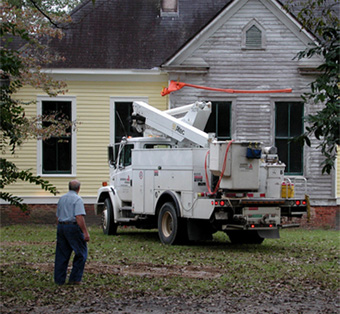
The Georgia Power pickup truck stopped by one day after we notified all the utilities we needed to dig for our sewer line. He needed to verify that we had no underground wires. We thought this pretty funny since we had been trying unsuccessfully for months to make Georgia Power understand that we did not have a temporary pole with a meter standing next to our house. (A typical construction project has a temporary power pole with meter and, in the case of Georgia Power, is a commercial account at $15 per month. A residential account was only $8 per month.) The billing department wouldn't even believe the meter reader when he called them up and said, I'm standing here, there is no pole.
We explained to the service employee that we needed to erect some scaffolding around the power lines so we could paint the gable end and it would be nice to have the lines insulated before we started work. Interestingly enough, Georgia Power did not our scaffolding anywhere near their unprotected lines, and they put in a work order right away.
About 8 p.m. one summer night we heard the rumble of a large truck and went out to see some newly installed "eels." Eels are super-insulators power company employees use when working around high-voltage lines.
Below we have our scaffolding up and it can be seen how close we were to the lines. Someone is getting a bit too comfortable working up there!